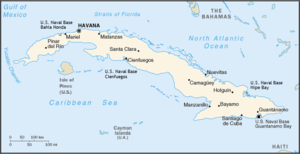- Cuban–American Treaty
-
The Cuban–American Treaty was signed on February 17, 1903, by the first president of Cuba, Tomás Estrada Palma, and on February 23, 1903, by the president of the United States, Theodore Roosevelt. The treaty stipulates that Republic of Cuba will perpetually lease to the United States the Guantánamo Bay area (surrounding areas of land and water) for the purpose of coaling and naval stations. The United States will have absolute jurisdiction and control over the area and in return will recognize the Republic of Cuba's ultimate sovereignty over the area. Cuban vessels involved in trade or war will have free passage through the waters.
The treaty actually fell short of the original desires of both the United States government and its military cabinet.[1] Their aim was to accomplish the leasing to the United States of a total of four naval bases located in strategically favorable port areas of Cuba, including Guantánamo Bay. The other three were Bahia Honda (close to the Cuban capital of Havana), Cienfuegos, and Nipe Bay.[1] The Isle of Pines was also considered for annexation into the U.S. This separate situation arose from a dispute because the island was not specifically mentioned in the Platt Amendment which defined Cuba's modern boundaries.
The government of Cuba believes it to be in violation of article 52 of the 1969 Vienna Convention on the Law of Treaties, which declares a treaty void if its conclusion has been procured by the threat or use of force.[2] However, Article 4 of the same document states that Vienna Convention on the Law of Treaties shall not be retroactively applied to any treaties made before itself.[3] The treaty was part of the Platt Amendment, conditions for the withdrawal of United States troops remaining in Cuba since the Spanish–American War. Professor Alfred-Maurice de Zayas also argues that the United States has broken the terms of the treaty by allowing commercial use of the land and not giving Cuba ultimate sovereignty over the area.[4]
The ongoing detention of prisoners at the base is in itself said to constitute a violation of the original treaty, which explicitly states that the United States is allowed "generally to do any and all things necessary to fit the premises for use as coaling or naval stations only, and for no other purpose." Such argument thus hinges upon whether detention of prisoners is a valid role of a naval or coaling station.
See also
- Cuba – United States relations
References
- ^ a b "Leasing of U.S. Base Guantánamo Bay". Suburban Emergency Management Project. January 29, 2010. http://www.semp.us/publications/biot_reader.php?BiotID=687. Retrieved December 19, 2010.
- ^ Vienna Convention of the Law of Treaties
- ^ Vienna Convention of the Law of Treaties
- ^ The Status Of Guantánamo Bay And The Status Of The Detainees, Alfred de Zayas
External links
- Cuban-American treaty(full text)
- 1969 Vienna Convention on the Law of Treaties (full text)
 Cuba – United States relations
Cuba – United States relationsBay of Pigs Invasion · Brothers to the Rescue · Commission for Assistance to a Free Cuba · Cuban American · Cuban-American lobby · Cuban dissident movement · Cuban Five · Cuban Missile Crisis · Elián González affair · Guantanamo Bay Naval Base · Helms–Burton Act · List of Cuba – United States aircraft hijackings · Luis Posada Carriles · Mariel boatlift · Operation Northwoods · Operation Peter Pan · Platt Amendment · Spanish–American War · United States Ambassador to Cuba · United States embargo against Cuba · United States Interests Section in Havana
 Categories:
Categories:- Treaties of the United States
- History of Cuba
- Cuba–United States relations
- 1903 in Cuba
- 1903 in the United States
- Treaties of Cuba
- Cuba–United States border
- Treaties concluded in 1903
Wikimedia Foundation. 2010.

